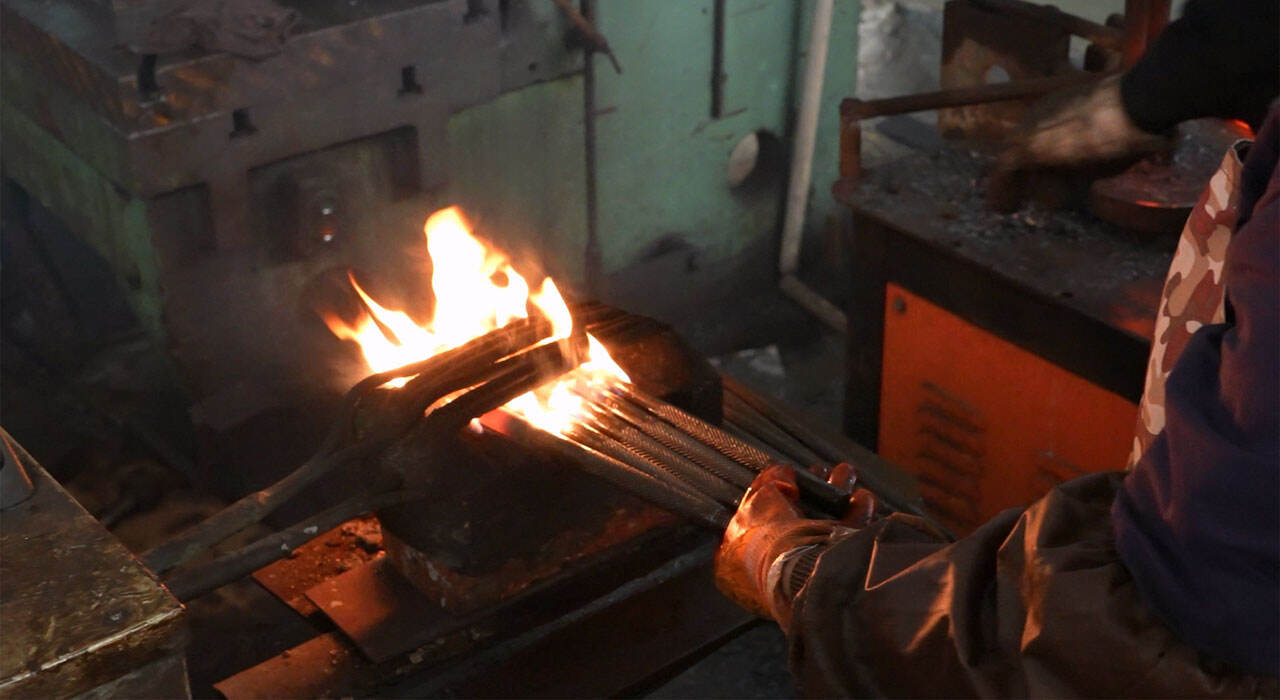Kā svarīgu saistīšanas elementu, šūti ir plaši izmantoti dažādās nozarēs. To ražošanas process ietver vairākas saites, un katrs no tiem lieliski ietekmē šūtu īpašības un kvalitāti. Tālāk sniegta pilna skaidrojuma par šūtu ražošanas procesu, kas galvenokārt ietver materiāla izvēli, drāšanas darbu, kalnu formēšanu, ciklu līdzināšanu, temperēšanu, virsmas apstrādi, kvalitātes pārbaudi, pakārtošanu un glabāšanu u.c.

Boltu sastāvdaļu materiāli parasti ir augstas kvalitātes ogļtīkls vai aliejuma tērauds. Atkarībā no dažādām izmantošanas prasībām tiek atlasīti dažādi tērauda marķieri. Augstas kvalitātes ogļtīkls piedāvā labāku plastiskumu, smagdzīgumu un griešanas īpašības, savukārt aliejuma tērauds ir ar augstāku stiprumu un izmūšanās atbalsta. Izmateriālu izvēlē ir jānodrošina, lai to himikāliskais sastāvs, mehāniskie īpašumi, nezudamais pārbaudes testi un citi parametri atbilst attiecīgajiem standartiem.

Priekšapstrāde ir svarīgs bolts ražošanas posms, galvenokārt ietverot materiāla šķelšanu, tīrīšanu un segojuma apstrādi. Šķelšana nozīmē materiālu apstrādi līdz garumam, kas piemērots kolēnu formēšanai, tīrīšana nodrošina materiāla virsmas notīrību no smakņām un oksīda skaldēm, savukārt segojuma apstrāde var uzlabot materiāla korozijas atbalstu.

Vircu izvilkcība ir procesa metode, ar kuru pakāpeniski samazina sākotnējo materiālu diametru, izmantojot vairākus stiepšanas un kompresijas posmus, lai iegūtu vajadzīgās specifikācijas virces vai stieņus. Šim procesam nepieciešama precīza kontrole pār stiprumu un stiepšanas skaitu, lai nodrošinātu, ka virce vai stienis ir vajadzīgā lielumā un formā.

Kalda formas izveide ir bultu ražošanas galvenais process. Iepriekš apstrādātie sākotnējie materiāli tiek pārvērsti par bultu prelimināro formu, izmantojot specializētu kalda formas izveides mašīnu. Šajā procesā kalda formas izveides mašīnas parametri, piemēram, spiediens, temperatūra un laiks, jākontrolē precīzi, lai nodrošinātu, ka bultas izmērs un forma atbilst prasībām.

Šķēršu veidošana ir svarīgs process metāla apstrādē un galvenokārt tiek izmantota, lai apstrādātu šķēršus. Principa pamatā ir metāla gabala plastiskā deformācija caur vieglām, lai izveidotu šķērus ar noteiktiem mērķiem un formām. Šķēršu veidošanas process var uzlabot fiksatoru, piemēram, bultu un ciepuru, savienojuma stiprumu un izmaksu, kā arī paplašināt to dienestspēju. Šķēršu veidošanas procesā jākontrolē parametri, piemēram, šķēršu veidošanas rata pagrieziena ātrums, piegādes ātrums un spiediens, lai nodrošinātu šķēršu kvalitāti un precizitāti.

Termaiska apstrāde ir svarīgs solis, lai mainītu metāla iekšējo struktūru, uzlabojot bultu stiprumu un korozijas atbildību caur uzturēšanu vai dzesēšanu. Termaiskās apstrādes procesā nepieciešama precīza temperatūras un laika kontrole, lai nodrošinātu bultu īpašības.

Lai uzlabotu bultu korozijas atdarinājumu un izskatu, parasti nepieciešama virsmas apstrāde. Parastie virsmas apstrādes veidi ieskaita zinkēšanu, hromēšanu, plastmasas aplīdzināšanu un malingošanu. Zinkēšana var uzlabot bultu korozijas atdarinājumu un ir piemērota ārpusē un mitruma vidē; hromēšana piedāvā labāku izmūšanās un korozijas atdarinājumu; plastmasas aplīdzināšana un malingošana nodrošina skaisto izskatu un noteiktu korozijas aizsardzību. Izvēlieties piemērotāko virsmas apstrādes metodi saskaņā ar izmantošanas prasībām.

Kvalitātes pārbaude ir svarīgs solis, lai nodrošinātu bultu kvalitāti. Pārbaudes punkti ietver izmēru pārbaudi, ārējās pazīmes pārbaudi, mehānisko īpašību pārbaudi un neuzsūdzinošo pārbaudi. Izmēru pārbaude galvenokārt pārbauda, vai bultas diametrs, garums un šķēpu parametri atbilst prasībām; ārējās pazīmes pārbaude koncentrējas uz to, vai bultas virsmā nav trūkumu, piemēram, sprādzņu, buramuma un rūgļu; mehānisko īpašību pārbaude ieskaita stiprinājuma pārbaudi, impulsa pārbaudi un cieņas pārbaudi, lai novērtētu bultu mehāniskās īpašības; neuzsūdzinošā pārbaude izmanto ultraklātus, X-starpējos un citus veidus, lai pārbaudītu bultu iekšējos trūkumus. Nepareiziem produktiem jābūt identificētiem, atdalītiem un apstrādātiem laicīgi.

Lai nodrošinātu bultu darbību un kvalitāti, nepieciešams pareizs iepakojums un glabāšana. Pirms iepakojuma bultu virsmā jānoņem olēds un smidzens. Iepakojuma materiāliem jābūt sausiem, tīriem un jādara ar noteiktu mēru vandējamo, trucienu un rūstuma aizsardzību. Iepakojuma metode var tikt atlasīta kā vienības vai partijas iepakojums atkarībā no klienta prasībām un transporta apstākļiem. Glabāšanas videi jābūt sausai un labi ventilētam vietam, izvairoties no tiešas saules gaismas un augstas temperatūras un mitruma apstākļiem, lai novērstu bultu rūstumu un koroziju. Regulāri pārbaudiet glabāšanas vidi, lai nodrošinātu atbilstību prasībām.

 Karstās ziņas
Karstās ziņas